MONDAY
MARCH 31 - 2014
10:00 - 12:00 - This
morning I cycled from home (Bridge Road) to Nore Barn
via the town millpond. From Nore Barn I went on to
Conigar Point before cutting back along the Selangor
Avenue path and down Victoria Road to home.
Town
Millpond swans
The Mute Swan nest by
the bridge on Emsworth Millpond was in a sorry state
when I passed by this morning. The water had
completely engulfed it along with the two eggs and the
pen was dragging bits of twigs and other materials in
a vain attempt to build it up. The cob was patrolling
nearby, though there was no sign of the other pair of
swans that usually engages its attention.
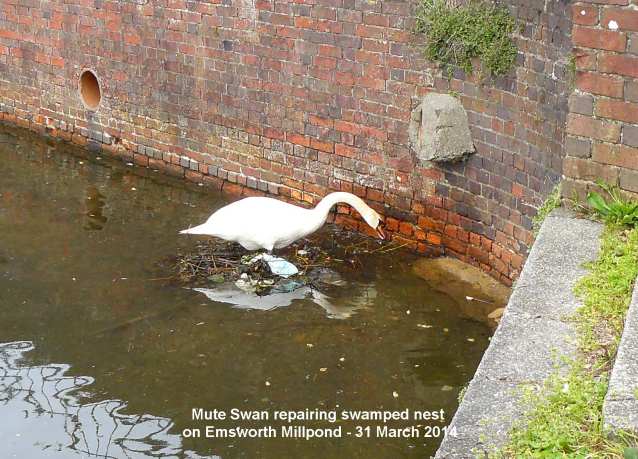
Nore
Barn
About 2 hours to high
water. The only birds in the stream were a Common
Redshank and two Black-headed Gulls. The harbour was
similarly quite empty of birds apart from a few ducks
and Oystercatcher calls.
Chris Berners-Price
told me that the Sparrowhawks were back in the
woods (western end) and hopefully would be nesting
there again as they have done (on and off) in previous
years.
Walking along the path
to the south of the woods, I noted Three-cornered
Garlic and Greater Stitchwort both in full
flower. The spathes of Lords and Ladies are now
standing up well, but all were closed up with no
spadix showing.
Three-cornered
Garlic
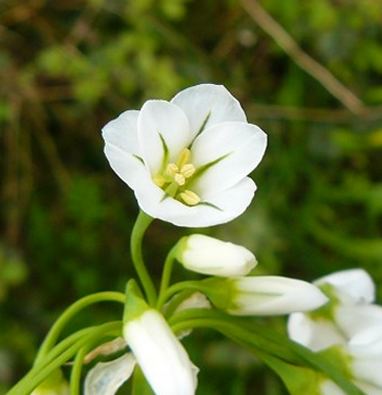
|
Greater
Stitchwort
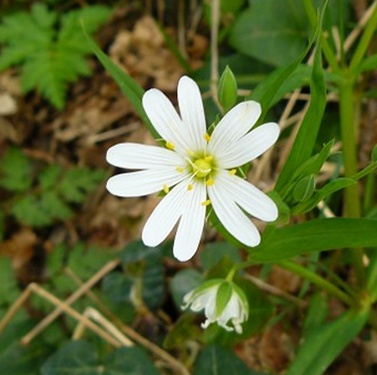
|
Conigar
Point field
I walked right round
the field behind Conigar Point which is still lying
fallow after having the Sweet Corn crop harvested in
the autumn. This field is regularly surveyed by Ralph
Hollins for wild flowers and I was interested to see
what I could find. Generally, the plants were best in
the northern area. Among those I could identify were
Sticky Mouse-ear, Scentless Mayweed, Common Field
Speedwell, Groundsel (no rayed forms), Field Pansy,
Common Fumitory, Field Woundwort (abundant), Field
Madder and Sun Spurge. Here are photos of some of the
more interesting ones.
Selangor
Avenue path
This is the long path
that runs from the north west corner of Nore Barn
Woods to the main Havant Road coming out opposite the
junction with Selangor Avenue. It is very muddy and
puddly in parts and I was pleased to have my bike to
cycle through the worst bits. The path has a good
selection of wild flowers including Common Dog-violet
(with pale notched spurs), Bluebells (just opening),
Greater Stitchwort, Holly with some flowers open,
Dog's Mercury. I also saw some Great Horsetail cones.
It is puzzling why Great Horsetail is relatively rare
in the local area whereas over on the Isle of Wight it
grows abundantly in many places and is a menace in
gardens and allotments where it takes over!
Great
Horsetail
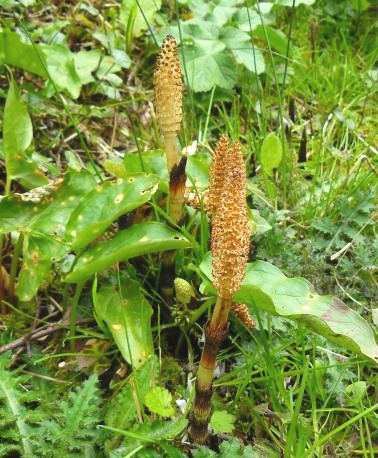
|
Holly
flower

|
Chiffchaffs were
singing everywhere. I heard a Blackcap song - my third
of the year in fairly good breeding habitat, so I
think we can safely assume the migrants have arrived.
Rookery
I counted 28 nests in
the Rookery behind the flats at the western end of
Victoria Road opposite the entrance to Emsworth
Primary School. This is a small increase on the 22
nests I counted at this time last year.
Malcolm's
news
Malcolm Phillips went
to Brook Meadow as usual today, but did not have much
luck with sightings apart from this rather nice Blue
Tit waiting outside its nesting hole in a Crack Willow
tree on the north path.
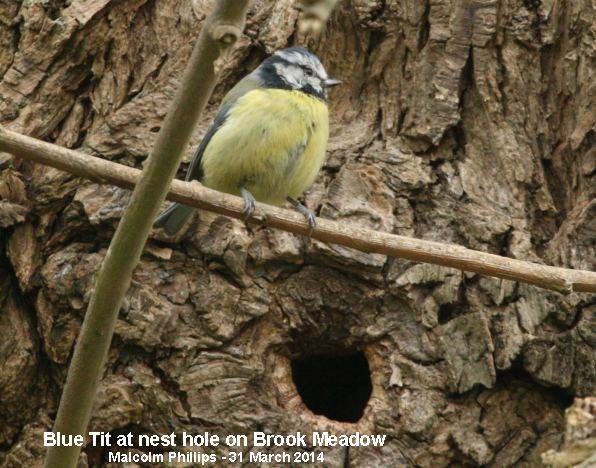
He had better luck in
his garden at home where he saw a Firecrest,
but could not get a decent photo of it.
SUNDAY
MARCH 30 - 2014
Mute
Swan news
The swan nest on the
town millpond near the bridge was completely swamped
when I passed by this afternoon. The pen was on the
water nearby, seemingly unconcerned. The cob was
further south with wings raised more concerned about
protecting territory from the south pair of swans.
They have not attempted any nest building.

Meanwhile, the swans
on Slipper Millpond have succeeded in building their
nest in the reedbeds in the north-east corner of the
pond where I have seen them several times before. The
pen was sitting on the nest this afternoon with the
cob nearby collecting bits of reed to reinforce the
nest. The nest will certainly need building up if it
is to avoid being swamped by the high spring tides.
But it looked OK today.
Coot
nests
I spent some time
trying to work out where the Coots were nesting on
Slipper Millpond. The three regular pairs have
certainly avoided the nest boxes on the rafts where
they have always nested in the past. This year, the
rafts have been covered with wires to deter to Great
Black-backed Gulls, but it looks as if this strategy
has also served to deter the Coots. I am fairly sure
the pair that normally nest on the north raft are now
nesting in the reedbeds in the north-east corner of
Slipper Millpond, fairly close to the swans. I saw one
of the Coots coming and going from the area marked on
the photo with nesting materials. I am not sure about
the other two pairs of Coot, if they are nesting at
all, that is.
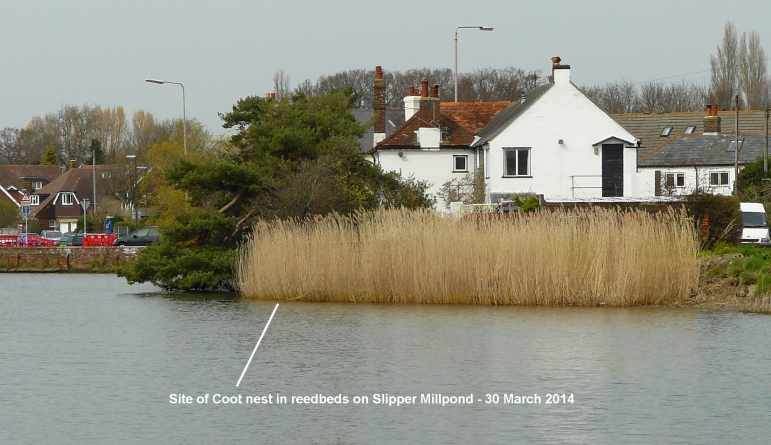
Brook
Meadow
Malcolm Phillips went
round the meadow for an hour today. He saw two
Buzzards soaring overhead at the north end of the
meadow. He also saw several butterflies, including
Peacock, Small Tortoiseshell, Brimstone, Comma and the
first Orange-Tip of the year on the meadow.
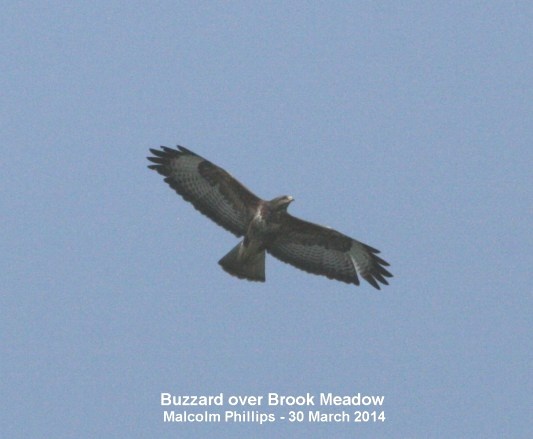
Nursery-web
spiders
Malcolm's most
interesting finds were two spiders which were clearly
early examples of Nursery-web spiders (Pisaura
mirabilis). We usually see these spiders in the summer
when their distinctive silken tents (ie nursery webs
containing the spiderlings) can be found in great
profusion around the meadow and on grassy banks and
road verges. In early spring we see the spiders, as
Malcolm did, stretched out on leaves sunning
themselves, waiting for flies and other insects to
pass by; they then use quick sprinting and strength to
overpower them. When resting or detecting prey, they
extend their first and second pairs of legs straight
out together at an angle. They are very variable in
colour as shown in the two photos, but always have a
pale line down the back.
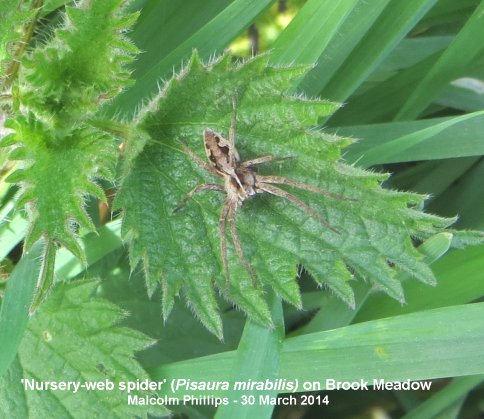
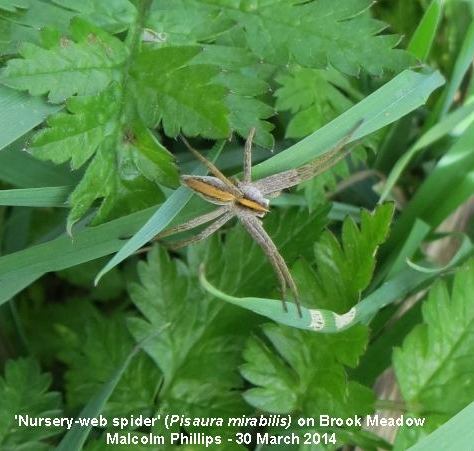
For more information
see . . . http://srs.britishspiders.org.uk/portal.php/p/Summary/s/Pisaura+mirabilis
SATURDAY
MARCH 29 - 2014
Emsworth
Swan news
The north pair of
swans on the millpond were at the nest near the bridge
at about 11am this morning watched by an increasingly
fascinated audience of people. There were two eggs in
the nest, but they were resting in a pool of water.
The other white object in the photo is litter not an
egg. The two swans seemed to be aware of the problem
as they were both engaged in gathering up small twigs
to build up the height of the nest, but there is an
acute scarcity of twigs on the pond. I think the only
hope for the nest is for the level of the water to be
controlled in the pond.
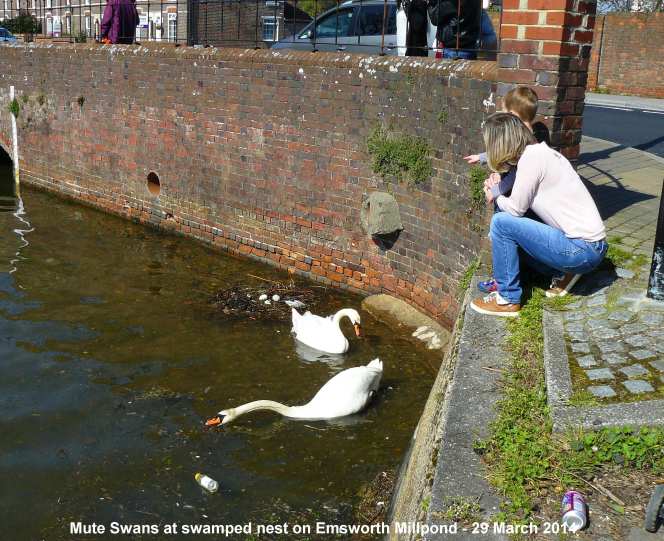
First
Orange Tip
I happened to meet
Robin Pottinger this morning and we chatted about who
would see the first Orange Tip of the year. Well, I
called in to see my son who lives in Church Path,
Emsworth and, hey presto, a male Orange Tip fluttered
through his back garden, closely followed by a male
Brimstone. Sadly, neither of them stopped for a photo.
This is about the right date to see the first Orange
Tip, which overwinters as a chrysalis. Last year they
were very late due to the cold spring, but in 2012 the
first one was seen on Mar 27 by Robin Pottinger.
Interestingly, and probably not by coincidence, the
first Cuckooflowers were also open on the
Bridge Road Wayside for the first time today.
Cuckooflowers are one of the main food plants of the
caterpillars of the Orange Tip.
Other
Emsworth news
I heard my second
Blackcap song of the year from bushes on the
path south of Brook Meadow that goes to Peter
Pond.
The long yellow Basford Willow catkins are
beginning to cascade down onto the ground from the
tall trees at the southern end of Palmer's Road Car
Park.

Farlington
Marshes
Heather Mills reported
on this morning's walk by the Havant Wildlife Group
around the marshes. Quite an exciting time with a
rescue thrown in! Full report and photos are on the
HWG web page at . . . http://familyfellows.com/hwg-walk-reports-2014.htm
Langstone
Mill Pond
Peter Milinets-Raby
visited Langstone Mill Pond this morning coming in
from the Wade Lane direction. 9:30am to 11:15am - very
high tide, brisk south wind! The highlight was bumping
into Ralph Hollins. Birding highlights included:
Along Wade Lane; Mistle Thrush collecting worms, Green
Woodpecker, Stock Dove, 2 to 8 Med Gulls going over
heading inland, 2 Chiffchaff singing, Blackcap
singing.
Horse paddock just north of millpond (though I learnt
from Ralph that this was once a cricket pitch to the
posh house!). 7 Teal, 12 Moorhen, 4 Grey Herons
present - Later watched the 'left nest pair' collect
long sticks from the edge of the paddock and return
(four journeys).
On the millpond: Grey Herons - Lots of activity with
the 'left nest pair'. Flying back and forth with
twigs. Observed the two birds mating on the barely
visible nest. All very promising! The 'right nest
pair' were quiet, with views of one bird just poking
its head above the edge of the tree on several
occasions. Very windy, so the birds were keeping
low!
Mute Swans - Female firmly on nest surrounded by loose
feathers and male swimming around and chasing
everything in sight, especially the Mallard.
Little Egrets - 24 birds clearly just roosting out the
high tide and wind. 16 birds actively gwooking and
guttural calling, chasing, carrying the odd stick etc.
Hard to say at this early stage how many are planning
to nest.
And saving the best for last again! I was surprised to
see that at the back of the pond the female Goosander
was fast asleep.
Off shore on the choppy waters: 2 Brent Geese, 14 Red
breasted Mergansers.
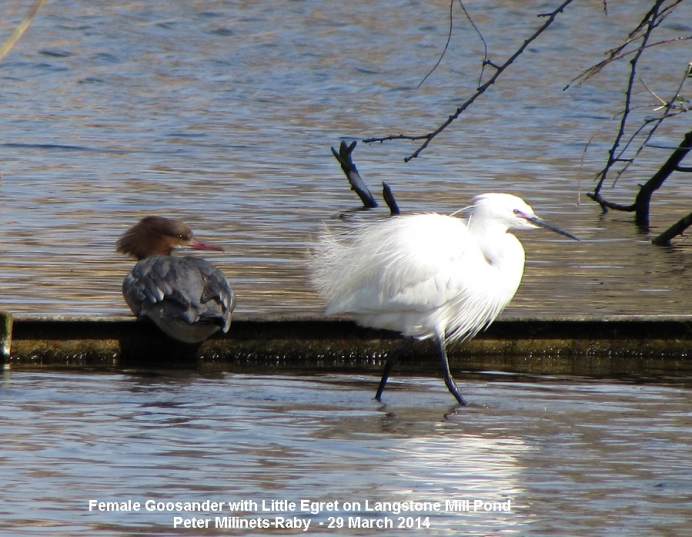
Colin's
photos
Finally, Colin Vanner
was on Hayling Island on this bright and sunny day and
got some splendid images including this fine
Sparrowhawk in flight - female?
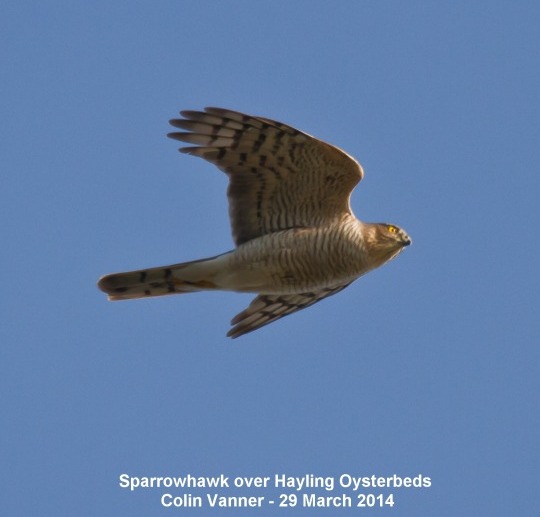
And I just could not
resist including this magnificent beast.
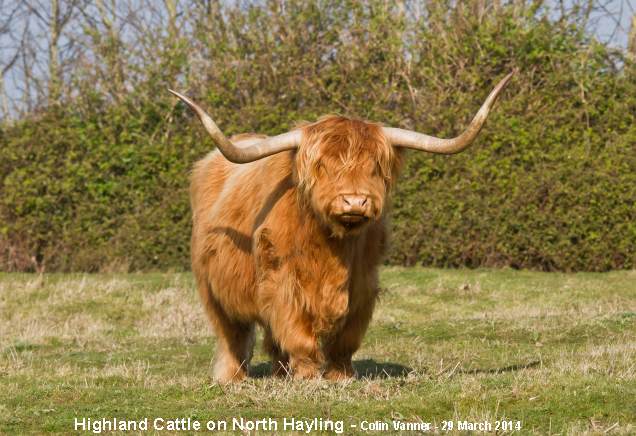
FRIDAY
MARCH 28 - 2014
Emsworth
Swan news
Maggie Gebbett
e-mailed me to say a friend of hers intervened in a
fight between swans on the millpond on Sunday. The big
cob was laying into another swan so Maggie's friend
waded in and stopped the fight. He then phoned the
RSPCA who came and took away both swans (one was
bleeding a lot.)
All was calm and
peaceful when I walked past this morning, with both
pairs of swans in their territories in the north and
south of the pond. The south pair was by the Slipper
Sailing Club building. The north pair were both near
the bridge, where the female was near the nest which
had one egg in it, as yesterday.
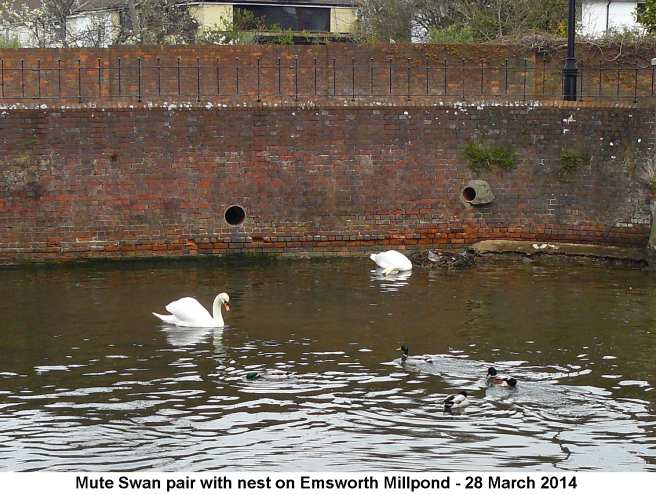
The nest is made
mostly of twigs left by the winter storms, though it
is flimsy, with the water lapping around, it could be
easily swamped. Last year, at the request of concerned
local residents, the Environment Agency controlled the
level of the water in the pond so the nest would not
be swamped. I wonder if this will happen this year?
Langstone
news
Ralph Hollins has been
keeping an eye on the Mute Swans nesting on Langstone
Mill Pond. They are far more advanced than the
Emsworth ones and already have 7 eggs in the nest.
Ralph reports the number of Egrets claiming nest sites
in the trees at the back of the pond had risen to 8.
There could also be two pairs of Grey Herons nesting
in the same area. See Ralph's wildlife diary for
details . . . http://ralph-hollins.net/Diary.htm
Chichester
Peregrines
Malcolm Phillips went
to see the Peregrines on Chichester Cathedral again
today and got some more excellent photos.
This
bird is launching itself off from one of the
towers
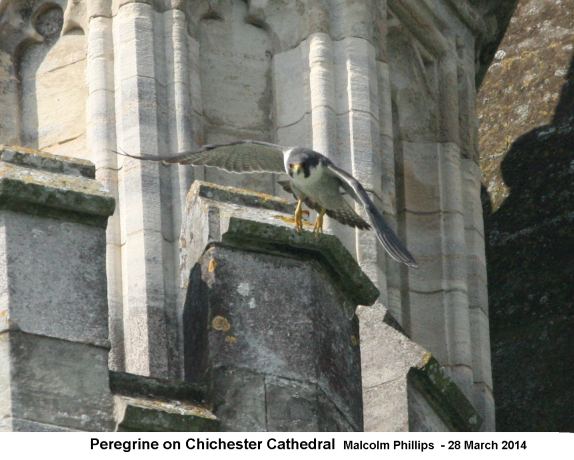
Here
is one in flight showing clearly the bird's barred
underparts
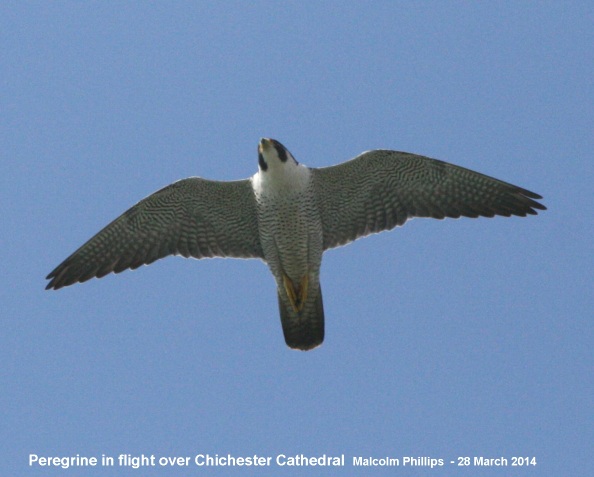
While watching the
Peregrines on Chichester Cathedral on Mar 26, David
Holdstock also saw a Sparrowhawk, 3 Red Kites and 3
Buzzards! That was quite a haul of raptors! David
noted that the RSPB will be at the cathedral from 11th
April until 5th July for their annual Peregrine watch.
(Posted on SOS Sightings).
THURSDAY
MARCH 27 - 2014
Hermitage
Millponds
A Coot was sitting on
a nest in the northern reeds on Peter Pond, just to
the right of the Kingfisher table. The pair of Great
Black-backed Gulls was on the water on Slipper
Millpond. Yesterday's swan 'nest' in the reedbeds was
unoccupied and looked a scrappy affair - not serious.
As far as I could see, the Coots are not using either
of the nest boxes on the north and south rafts.
Mute
Swan nesting
There is some action
over on the town millpond with the female of the north
pair sitting on a rudimentary nest of twigs beneath
the bridge in much the same position as last year. She
has laid one egg! The nesting swan is already
attracting the attention of people passing by and no
doubt will continue to be a huge draw just like the
nest last year which produced one cygnet.
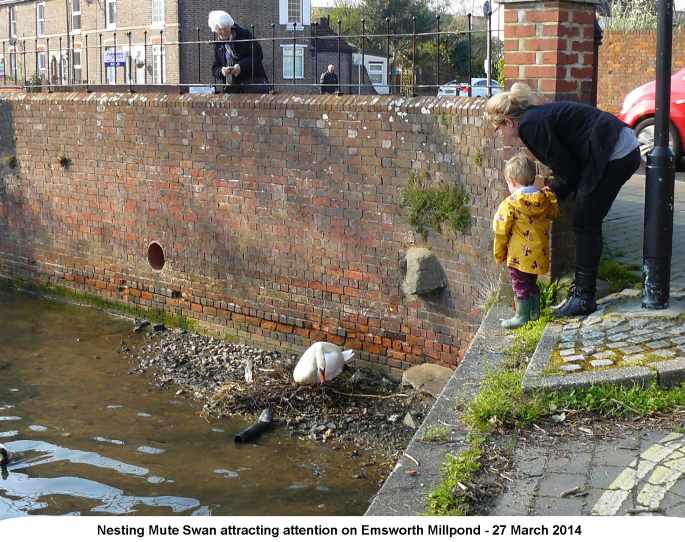
Waysides
News
There is a very nice
patch of Early Dog-violets flowering on the
grass verge on the east side of New Brighton Road
opposite the northern junction with Christopher Way -
thanks to Ralph Hollins for pointing that out.
Here
is one of the flowers showing the straight unnotched
spur and pointed leaves
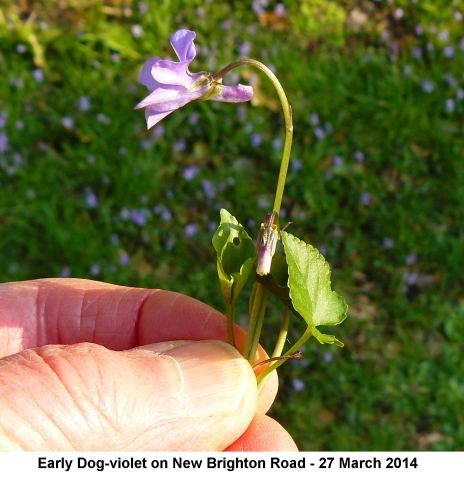
The first Meadow
Foxtail of the year is out on the Westbourne Open
Space at the top of Westbourne Avenue. It is a bit
earlier than usual?

WEDNESDAY
MARCH 26 - 2014
10:00 - 12:00 - I
cycled from Emsworth to Thorney this morning to see
what was going on. The answer was not a lot!
Emsworth
Harbour
I started at Nore Barn
where earlier Maggie Gebbett told me she had observed
Greenshank, Common Redshank and Little Egret in the
stream. The tide had fallen a good bit by the time I
arrived and the only bird left in the stream area was
a Little Egret.
A Chiffchaff was singing in the north wood by
Maisemore Gardens. Coming back along Western Parade I
noticed Hoary Cress in bud, but not in flower.
I counted 15 Mediterranean Gulls in the eastern
harbour, 11 Shelduck and 6 Brent Geese.
Slipper
Millpond
On to Slipper Millpond
where the pair of Great Black-backed Gulls was
eyeing up the raft they nested on for the past two
years, but which is now inaccessible. Where will they
go?
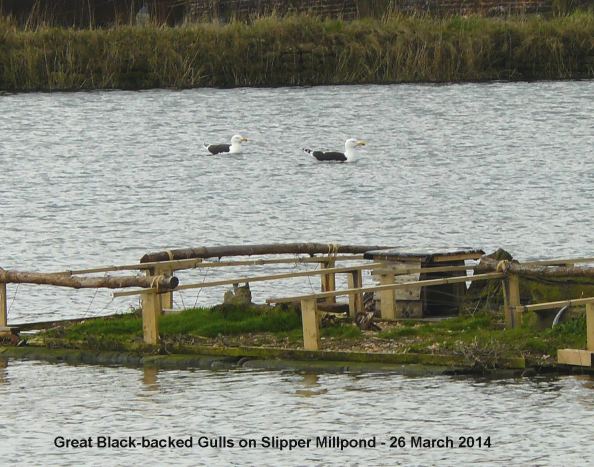
The female Mute
Swan of the pair was sitting on a nest in the
reedbeds in the north-east corner of the pond. This is
where I have seen them on several occasions. However,
it is rather a low area and could be swamped by the
high spring tides this weekend.

Thorney
From the marina
seawall I could see a pair of Mute Swans near the
entrance to the marina which could be the pair that
nested on the embankment last year. But there's no
sign of any nest there as yet.
The pair of Tufted Ducks was still on the pond of the
Deckhouses Estate, but no sign of any nesting.
A notice at the start of the Wickor Bank indicated
that the west Thorney path was closed for reasons of
public safety.
Chiffchaffs were singing along the old NRA track, but
no sign of any Swallows.
I heard two Cetti's Warblers singing either side of
the Little Deeps. I could not see any Mute Swans on
the deeps.
Chichester
Peregrines
Malcolm Phillips went
Chichester today and got some photos of the Peregrines
on the Cathedral, in one he caught them mating. He
also saw A Red Kite flying overhead.
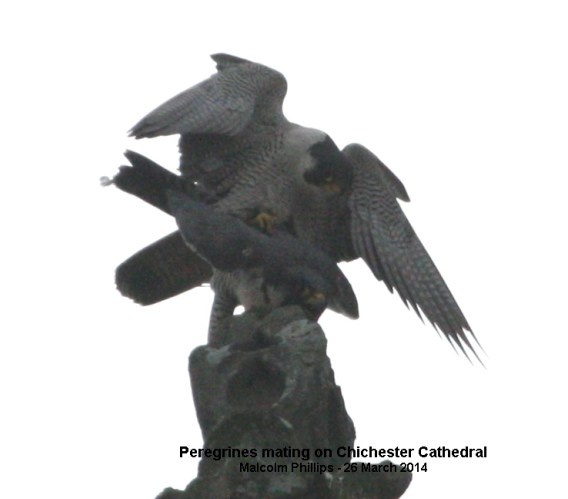
Brook
Meadow North Bridge
Looking through some
old diaries, I noted that the north bridge on Brook
Meadow was erected 20 years ago in March 1994. Before
that one had to wade across the river to get onto the
meadow, as related by many people interviewed by
Frances Jannaway for her book 'Brook Meadow through
the ages'.
MONDAY
MARCH 24 - 2014
Summer
Snowflake
The level of
the River Ems is gradually falling on Brook Meadow
which means it is now possible to walk along the
riverside path through Palmer's Road Copse from the
south bridge, though the path is still very wet and
muddy. This enabled me to get a good look at two
clumps of flowering Summer Snowflake (Leucojum
aestivum) which survived the river flooding its
banks.

This plant is misnamed
as it flowers in the spring and should not be confused
with Spring Snowflake (Leucojum vernun) which
is a very rare plant. Summer Snowflake is an
attractive plant with white flowers in small drooping
umbels. Its petals have a distinctive green spot near
the tips. The rather similar looking Three-cornered
Garlic (Allium triquetrum) is distinguished by
having a green stripe down the centre of each petal as
well as a strong garlic smell. Summer Snowflake occurs
as a native plant mostly in winter-flooded riverside
habitats and occasionally in meadows and woodland
rides. However, it also occurs as a garden escape,
probably accounts for the two specimens in Palmer's
Road Copse.
Blackcap
song
I have been
listening out for Blackcap song for the past week and
finally heard one this morning for the first time this
spring, from the trees in Palmer's Road Copse near the
south bridge. This is about the expected date for the
first song, though last year they were very late due
to the exceptionally cold spring. I had previously
heard a Blackcap song from a neighbour's garden on Mar
16, but I always put these garden songsters down as
wintering birds limbering up before their journey back
to the continent. In contrast, today's bird was in
regular breeding habitat and was almost certainly a
migrant. A Chiffchaff was singing nearby, also a
migrant. Whitethroat is the other main summer visitor
to Brook Meadow, but they always arrive well into
April.
Water
Vole
Robin
Pottinger saw his first Water Vole of the year at
11.50 am on the north river on Brook Meadow about
halfway between the north bend and the north-east
corner. This is section A1 by the railway embankment
where most of this year's sightings have been. It was
munching on some greenery at the water's edge on the
north side of the stream.
Fox
at night
Chris Oakley
has been trying out a night sensor camera in his
garden and so far has caught three different cats and
one fox. Last night he put out a road kill Pheasant as
bait which attracted a Red Fox again shortly after
1am. The fox took the bait immediately, then spent
about an hour searching around the garden. On one
occasion it brought back one of the wings and even
inspected the camera sniffing at the lens. Chris will
set the camera on video tonight, which should be
interesting.

Fox
in daylight
Malcolm
Phillips also got a photo of a Fox, but in broad
daylight during a walk on Hayling Island. He said the
fox was only about 15 feet away and paid no attention
to him and his companion.
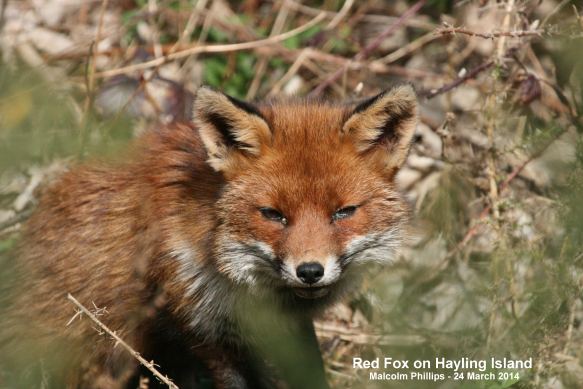
Langstone
Mill Pond
Peter
Milinets-Raby paid another visit to Langstone Mill
Pond late this morning (11:45am to 1pm - very low
tide).
3 Greenshank off shore (one in the creek by the mill -
coloured ringed G-BRtag. This could be one of the
birds newly ringed with a geo-tag by Pete Potts on
Hayling Island on Jan 13.
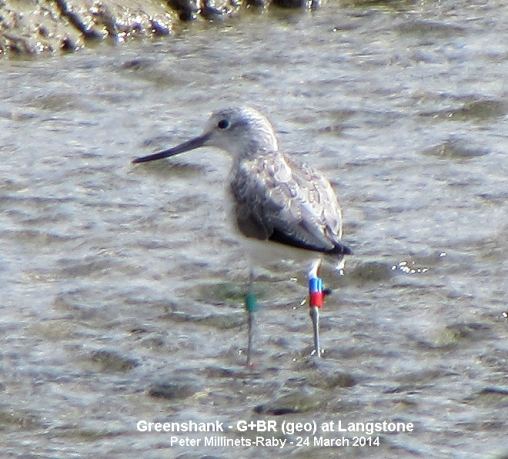
On the low tide mud:
22 Shelduck, 55 Bar-tailed Godwits, 3 Black-tailed
Godwits, 37 Brent Geese, 14 Teal, 2 Med Gulls.
In the channel: 13 Red Breasted Mergansers and a Great
Crested Grebe - a bit too choppy and windy to pick out
the Goosander! And, very distantly along the channel
shoreline by Conigar Point were 7 Brent Geese and the
Black Brant.
On the pond: 7 Little Egrets - One clearly sitting on
a nest in the Grey Heron tree. Two others in the tree
on the island (viewed from the back of the mill) stood
looking interested and occasionally calling. The
others were clearly just roosting. I think the cold
weather has put them off for a few days!
A pair of Grey Herons was on the usual tree. Watched
the female leave for a stretch and a fly round, then
return and muscle her way back onto the nest and sit
down out of sight. In the photo the male is on the
left and probably stood on the nest and the female on
the right just returned from a short one minute fly
around. Lots of display and stick moving observed,
before she then moved in to the left of the male and
sat down!
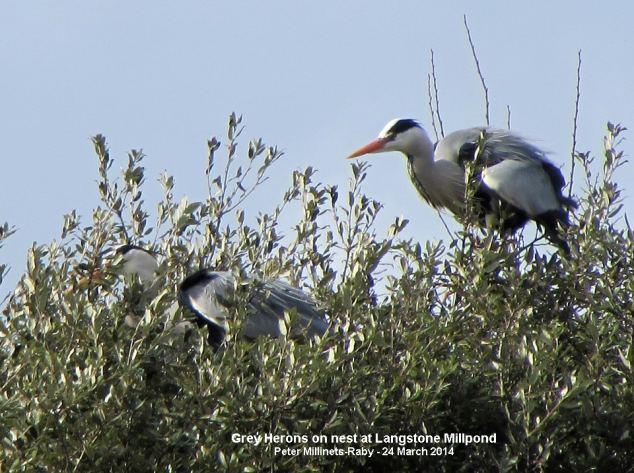
Mute Swan pair - On
arrival the male was sitting on the nest and 20
minutes later the female came and their swapped
duties. Five eggs noticed as they changed over.
Horse paddock north of pond: 10 Moorhen.
And, saving the best for last again: A commotion of
gulls and corvids made me turn around and in the air
was an Osprey with a fish in its talons
(glinting in the sunshine). The Osprey gained height,
circled around before drifting off north up along Pook
Lane direction. Also in the air at the same time was a
Buzzard. All this in just over an hour!
SUNDAY
MARCH 23 - 2014
Bluebells
in Ashling Wood
I went over to
Ashling Wood to see if there were any Bluebells were
out. This is always the best woodland for Bluebells
and they are usually out before the end of March,
though last year they were very late due to the cold
spring. I accessed the wood from the usual stile on
the east side of the wood where the Rookery was busy
and noisy. It was great to find a few Bluebell flowers
here and there in the woodland to the north of the
path.
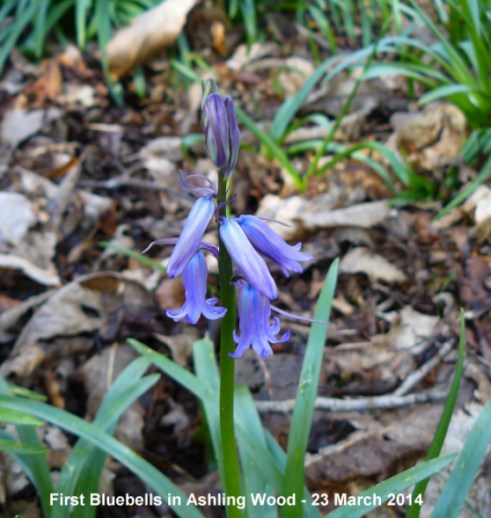
However, not so great
was the fencing that was being erected along the edge
of the path to prevent access to the wood. I spoke to
the lady owner who was working there; she told me the
fencing was necessary due to vandalism, but assured me
that a 'permissive path' would be created into the
woodland for Bluebell time. I hope so, as this is a
truly wonderful wood to see Bluebells. I suggest going
to see them in a week or so, though be prepared for
distant views. Other flowers in the woodland included
Wood Anemones and Dog's Mercury.
I checked Hollybank Woods on the way home, but there
were no Bluebells showing as yet in the northern
section, but plenty of leaves.
White
Comfrey on Bridge Road Wayside
A clump of
White Comfrey (Symphytum orientale) is in
flower on the east bank of the Westbrook Stream on the
Bridge Road Wayside behind the interpretation board.
This is the first White Comfrey to be recorded on any
of the Emsworth waysides. White Comfrey is
distinguished from Common Comfrey by having pure white
flowers and calyx teeth less than half the length of
the tube. Both these features show up well on this
photo.
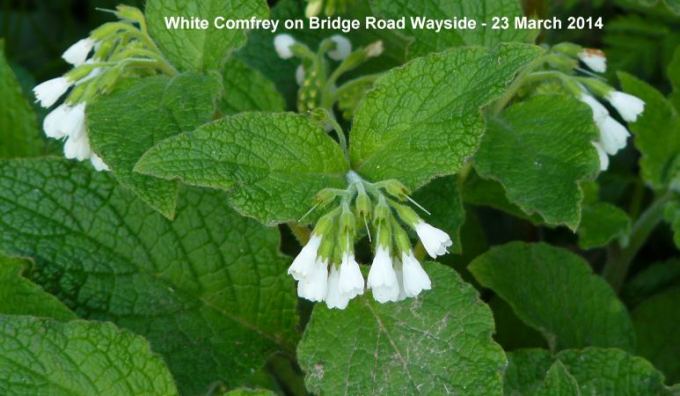
From The New Atlas:
This perennial herb is found as an escape or outcast
in hedgerows and copses, on lanesides, by roads and
railways, and on waste ground. It is often
naturalised, and sometimes regenerates from seed.
Neophyte (change +1.83).
S. orientale was introduced to gardens by 1752, when
it was known to have been grown in Cambridge, and was
known from the wild by 1849. Its distribution has
increased greatly since the 1962 Atlas owing to a
genuine spread, although part of the increase is also
due to better recording of alien species. Native of S.
Russia, N.W. Turkey and the Caucasus.
Ravens
nesting in Stansted Forest
My wife and I
saw a pair of Ravens in front of Stansted House on Feb
26 and we wondered whether they might be nesting.
Today, I met Michael Prior (Head Forester of Stansted)
who said he was fairly confident that a pair was
nesting on the estate for the first time. That is very
good news indeed .
Spotted
Redshank leaves Nore Barn
I checked Nore
Barn at 14:00 which was about 2 hours to high water.
The only birds in the stream were Mute Swan, Little
Egret, Oystercatcher, Greenshank, Common Redshank and
Black-headed Gull, but no Spotted Redshank. It was
interesting to see the Greenshank and Common Redshank
feeding closely together, rather like the Greenshank
and Spotted Redshank used to.
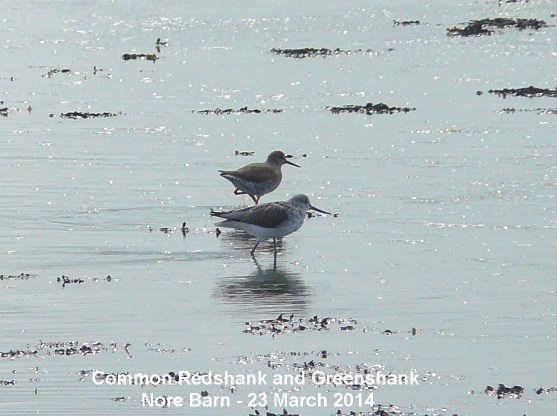
I checked the pond in
the wet field at the head of the creek, but there was
nothing there. So, I think we can safely conclude that
the Spotted Redshank has now left on its journey back
to its breeding grounds in the north. The last
sighting was on Mar 14. Will it return to Nore Barn
for a 11th year?
SATURDAY
MARCH 22 - 2014
Spring
birds
Chiffchaffs
have been singing their cheery 'chiff-chaff' song for
at least 2 weeks on Brook Meadow. Today, Malcolm
Phillips managed to get a photo of the first of our
summer visitors.
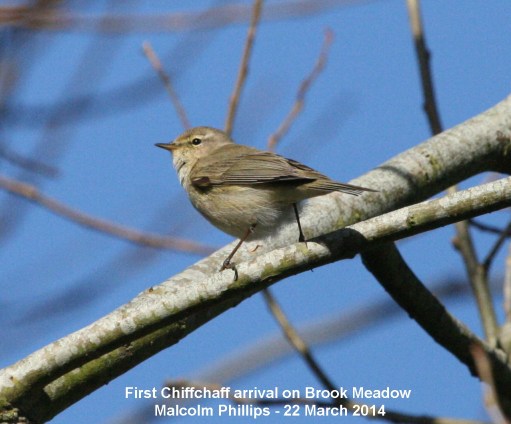
Spring flowers
Yesterday, I
saw my first Cuckooflowers of the year on an
embankment in Kingston near Lewes. I checked the
Bridge Road Wayside where I could just make out pink
petals of some plants. This is early as they have not
been seen before April in previous years.
Today, while walking around the Chichester walls I saw
both Red and White Campion in flower.
Also, on the Chichester walls I found one plant of
Wild Carrot in flower.
Forget-me-nots are in flower along Lumley Road,
probably a garden escape.
Slipper
Millpond
The Mute
Swan pair was by the Hermitage Bridge this
afternoon, but there is no sign of nesting. I have not
seen them on Peter Pond for a few weeks, which
suggests they will not be nesting there this year.
The two Great Black-backed Gulls were both
perched on the edge of the southern raft, but there
seems little prospect of their nesting there as the
raft is small and has a tent structure of wires,
making access difficult. But they are not giving up
easily!
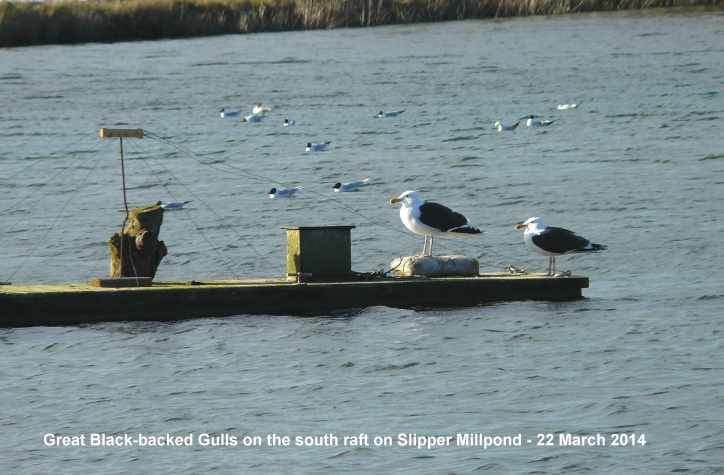
Meanwhile, the calls
of Mediterranean Gulls could be clearly heard
as they made their way onto the pond from a day
foraging in the fields. Here are two of them close
together on the pond with their black hoods, red bills
and white eye rings showing particularly well in the
afternoon sunshine.
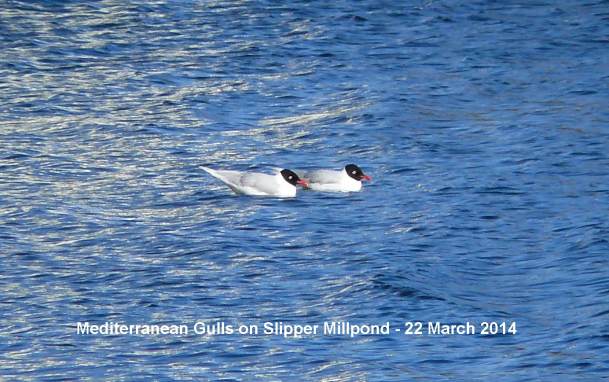
Warblington
This morning
(10am to 11:15am) Peter Milinets-Raby did a quick
circular walk from the Warblington church to Conigar
Point via the stubble fields and back along the
Warblington shore. The highlights were as follows:
5 Little Egrets in one of the cow fields near Castle
Farm. Great Spotted Woodpecker in the cemetery.
Stubble fields behind Conigar Point: 17 Linnets, 2
Goldfinch, 4 Skylarks, Single Meadow Pipit, male Reed
Bunting, 2 Stock Doves.
Conigar Point (low tide): Empty except for 2 Lesser
Black-backed Gulls and 2 Med Gulls.
Off Pook Lane: 30 Shelduck, 21 Brent Geese, Black
Brant surprisingly still present with these geese
on the mud., Out in the channel the female
Goosander was seen with 12 Red Breasted
Mergansers and a Great Crested Grebe. Along the edge
of the mud were 56 Bar-tailed Godwits, 19 Teal and 3
Grey Plover.
The only migrational movement observed were 4 Meadow
Pipits heading north (though I did hear a few more
moving north but did not see them).
FRIDAY
MARCH 21 - 2014
Langstone
Mill Pond
Peter
Milinets-Raby spent an hour at Langstone Mill Pond
(Noon to 1pm). The tide was pushing in just covering
the last bits of salt marsh. Amazingly 7
Greenshank present (G-R/BtagB, RG/YtagY, G-R/YtagY
and YN/YtagY). I hope these are all correct, as the
birds were up to their tummies in water and it took
patience to get the details.
Also present 47 Bar-tailed Godwit, 11 Knot, 21 Grey
Plover, 28 Brent Geese, 18 Teal, 4 Med Gulls and 13
Red Breasted Mergansers. The Godwits and Greenshank
flew off towards Thorney when the tide covered the
salt marsh.
On the pond: Chiffchaff singing. Mute Swans - female
off the nest having a swim around and a little brush
up whilst the male stood guard over the nest which
contained two eggs. The female was back on the
nest after 20 minutes.
35 Little Egrets roosting - disappointingly
very quiet, no noisy activity or chasing and no egrets
on any of the potential sites I saw them the other day
and which were also mentioned by Ralph Hollins. I only
counted 9 birds in breeding plumes and two with red
feet. A bit of a step backwards!
A single Grey Heron roosting - pink flushed bill
(probably the mate of the other bird). And, deep in
the 'tree' with the aid of a scope I was able to
determine that there was a Grey Heron shape sat down.
On what is anyone's guess! It even wiggled as it
settled down!
Paddock (virtually dried up): Fox present - hence all
the Teal off shore. Just 10 Moorhen.
And saving the best for last: Perched on one of the
fallen trees at the very rear of the millpond was a
female Goosander. It came off its perch for
five minutes, had a preen and a little swim around
then went back to the fallen tree to
snooze.
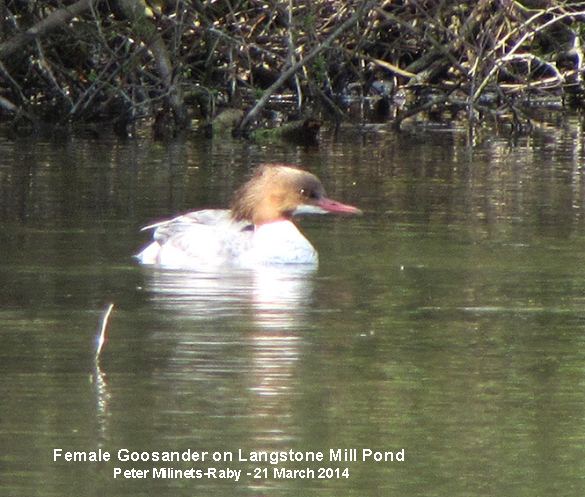
THURSDAY
MARCH 20 - 2014
Brook
Meadow - Conservation work session
I went over to
the meadow this morning mainly to take photos of the
work session. The workday was well attended with 13
volunteers. A passing lady kindly offered to take the
group photo which meant I could take part in it for a
change.
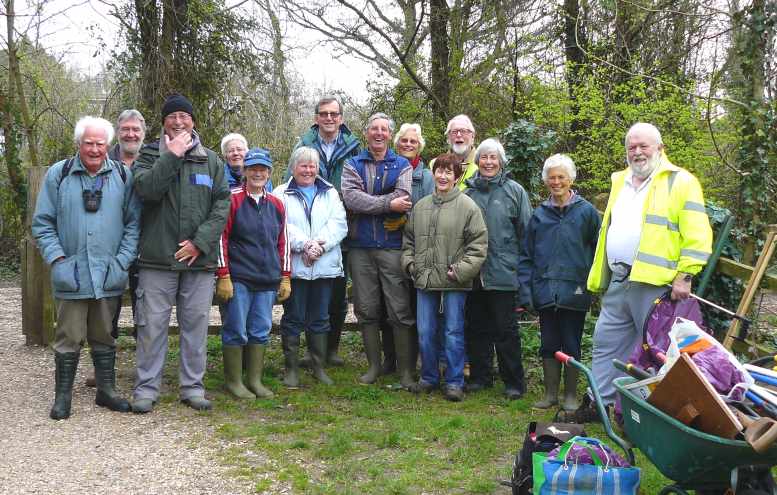
Maurice Lillie
explained the morning's jobs to the volunteers. These
concerned clearing debris from the south meadow,
cutting back the edges of the raised paths, attending
to damaged dead hedges on the river banks and litter
picking. Lesley Harris showed the group the new shirts
with the Brook Meadow Conservation Group logo and she
took orders for a good number on the spot.
For
full report and more photos go to . . .
http://www.brook-meadow.hampshire.org.uk/bm-diary-2014a.html
Butterbur
count
I took the
opportunity to carry out the annual count of Butterbur
flower spikes on Brook Meadow. As can be seen in the
following table, the overall number of spikes remains
very high, but is well down on last year's record
total. The embankment immediately below the seat still
accounts for the major proportion of the spikes - 76%
of the total. The next best area is the eastern end of
the causeway, but numbers on the river bank near the
sluice gate have gone down a lot. The luxurious growth
of Winter Heliotrope on the river bank south of the
sluice gate probably obscured some from my sight. Low
numbers in the south meadow are probably due to the
fact that this area was under water for several weeks
in Jan and Feb and has only just gone down. I will
carry out another count in a couple of weeks time to
see if things have changed.
|
.
|
2014
|
2013
|
2012
|
2011
|
2010
|
|
Embank
|
630
|
780
|
330
|
366
|
302
|
|
river
bank
|
53
|
110
|
93
|
248
|
169
|
|
s md
|
23
|
146
|
24
|
92
|
20
|
|
cause
E
|
118
|
164
|
99
|
142
|
106
|
|
TOTAL
|
824
|
1,150
|
546
|
859
|
597
|
This
chart shows the total Butterbur counts for each
year

Wildlife
observations on Brook Meadow
Pam Phillips
reported seeing a Rabbit near the cuttings tip
north of Lumley copse.
The brown spikelets of Greater Pond Sedge are
starting to show near the Lumley Stream as are the
spikes of Divided Sedge on the Lumley area.
Sharp-flowered Rush leaves are very prominent
on the western side of the Lumley area.
There are lots of fresh clumps of Hemlock
Water-dropwort in the south meadow, probably
promoted by the very wet conditions. The leaves of
Common Comfrey are also showing well.
The Goat and Grey Willows are now looking
particularly attractive, some trees with yellow male
catkins and others with green female catkins. Here are
female catkins of the Goat Willow near the Lumley gate
with Gooseberry Cottage in the background.
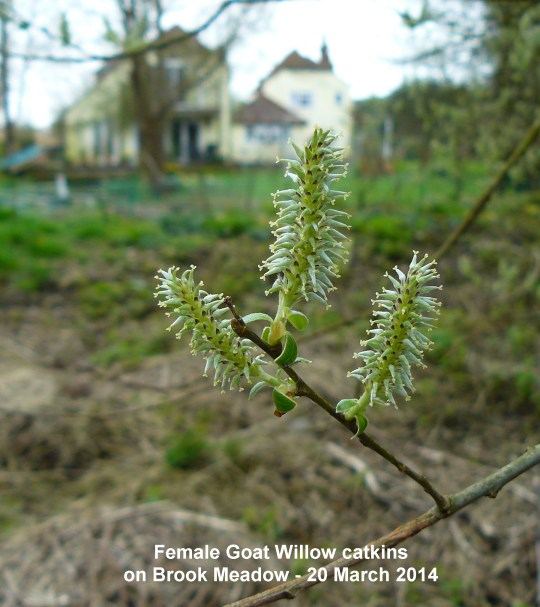
Spotted
Redshank final sighting?
Paul Dogman
was at Nore Barn stream on the 14th March to see what
was probably the final appearance of the famous
Spotted Redshank for this winter season. And what a
fine photo Paul got to see the bird out. The
Greenshank was also present in the stream. Paul says,
"I felt very lucky to have seen such wonderful birds
so close" which is a thought echoed by so many people
over the past 10 years. Roll on for the 11th year I
say.
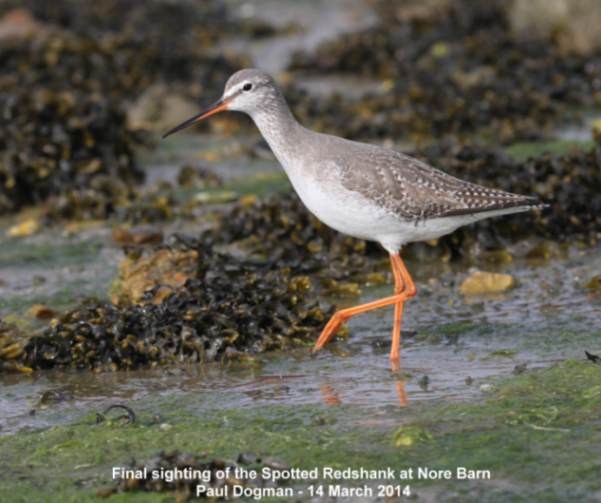
OTHER
NEWS
Chris Oakley
has a carpet of lovely Early Dog Violets
outside his house in North Emsworth. They come up each
year but the Council grass cutters usually put paid to
them before they flower. This year they were lucky.
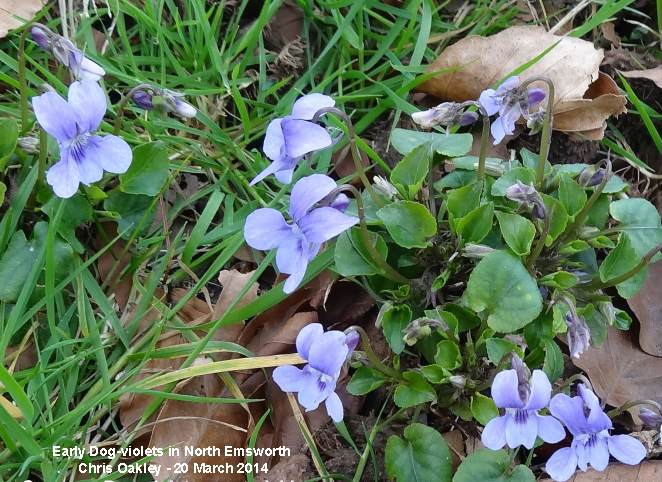
Chris also had a
Common Toad in his garden which almost suffered
the same fate as the Violets when the mower got
perilously close.

Roy Hay sent me this
unusual photo of four of eight Shelduck which
were perched on a rooftop near Fishbourne Mill Pond
this morning. Roy has seen Mallard on a roof before
but this is the first time he'd seen eight
Shelduck.
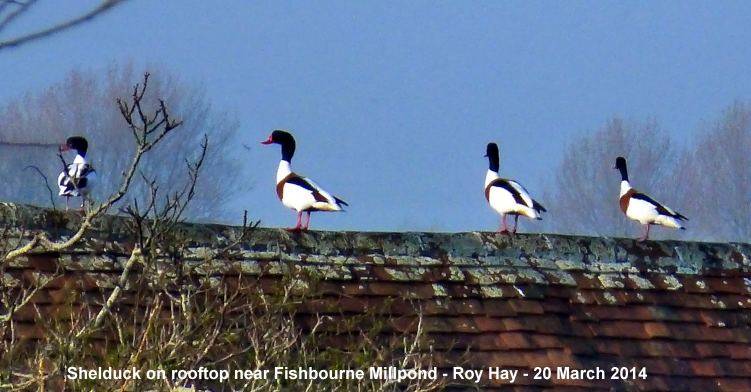
Bird
Song web site
Ralph Hollins
highly recommends the following web site for an
astonishing range of bird songs from all over the
world. They are all there, along with sonograms. . . .
http://www.xeno-canto.org/
Enter the name of a bird species in the Search Box on
the top line of the page and click the Search Button,
and you will be presented with a list of recordings
(with details of where they were made, how long they
are, etc) and all you have to do to hear the recording
is to click the button in the left hand margin of the
page against the recording you are interested in.
Quiet
winter in the garden
The BTO Garden
BirdWatch 2013 annual results showed how a chilly
March brought record numbers of birds into gardens
but, from September onwards, with bumper seed and
berry crops, it turned out to be one of the quietest
winters for garden birds in the last decade. You can
find out more about how individual species fared on
the results pages. Look at Greenfinch for example. Go
to . . . http://bto-enews.org/IG4-28YW9-3RN36S-Z5Q3X-0/c.aspx
WEDNESDAY
MARCH 19 - 2014
Reptile
survey
Jennifer Rye
(Chairperson of the Brook Meadow Conservation Group)
and I met up with Sam Lunn and a colleague from Azure
Ecology (an ecology consultancy based in West Sussex)
on Brook Meadow. They will conducted a reptile survey
on the meadow, specifically of Slow-worms and Common
Lizards. The idea behind the survey is to determine
the size of the existing reptile population prior to
relocating others to the meadow from a building
development site they are working on at Clay Lane,
Fishbourne. If the meadow were to have a substantial
reptile population already then it would not make
ecological sense to locate any more there. However,
this is unlikely to be the case as sightings of
reptiles on Brook Meadow are uncommon. Here is
Jennifer discussing the location of the mats with the
ecologists.
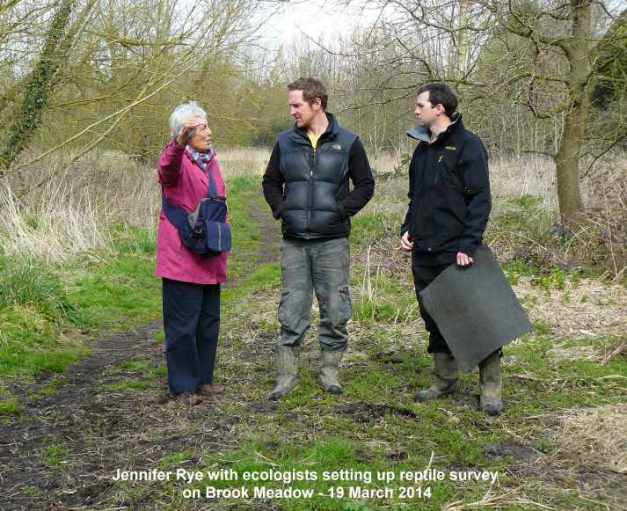
We all walked round
the meadow to determine the best sites to locate the
felt mats to be used in the survey. I think 9 mats
were used in total, placed around the meadow; three on
the Seagull Lane patch, three on the northern part of
the north meadow including one of the cuttings pile in
the north-east corner, one in the Rowan plantation and
one on the cutting pile on the east side of the north
meadow and finally one on the Alder Buckthorn
plantation below the causeway. Here is Sam with a
reptile mat to locate.

Sam and his colleague
will return in a couple of weeks to examine the mats
to see if any reptiles have made their homes
underneath them. They will be looked at from time to
time after that. It is important that the mats are not
disturbed during the survey as this will scare off any
reptiles using them.
Wildlife
observations
The sharp eyes
of the two ecologists spotted three small Brown
Trout in the river beneath the south bridge.
I heard the distinctive song of two
Chiffchaffs, one in Palmer's Road Copse and the
other in Lumley copse, both very likely to be
migrants. There was no sound of Blackcap which is will
be the next migrant to appear on the meadow.
I watched a Blue Tit going in and out of a small
nest hole in one of the Crack Willow trees along
the north path. This could be the bird that Malcolm
Phillips photographed here on March 9.

Malcolm Phillips was
on Brook Meadow this afternoon when he also spotted
two Brown Trout from the south bridge. He also got
this rather nice photo of a Goldfinch; such an
attractive bird which we have not had on the blog for
a while.
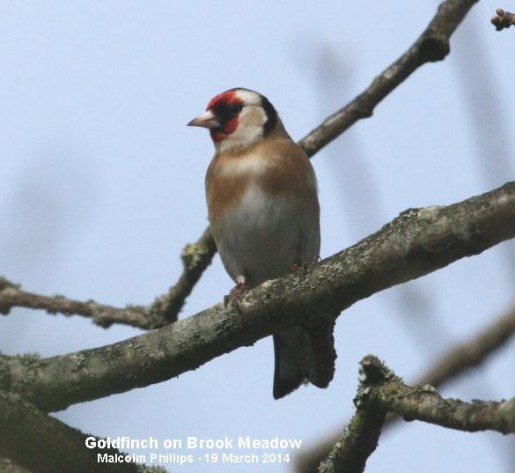
Emsworth
Millpond
10:00 - The
two pairs of Mute Swans were the only swans on
the millpond when I passed this morning. The other
lone swan that used to live on the grass verge on
Bridgefoot Path appears to have gone, probably driven
off by the resident pairs.
Now the immediate
threat of flooding has gone, the sluice gates have
been closed and the millpond is reasonably full of
water and looks like a millpond again. However, this
poses a problem for the swans' of nest building as
they would need to start from scratch on the bottom of
the pond and build up, which would be a difficult task
considering the paucity of nest building material on
the pond. Last year, when the swan was on the nest
near the bridge, local residents appealed to the
Environment Agency to control the sluice to maintain a
low level of water in the pond so as to prevent the
nest being swamped. It will be interesting to see what
happens this year once nest building starts.
Slipper
Millpond
The two
Great Black-backed Gulls were both on Slipper
Millpond this morning, looking rather forlornly I
thought at the raft where they have nested for the
last two years, but which is now covered in wires to
prevent their nesting this year.
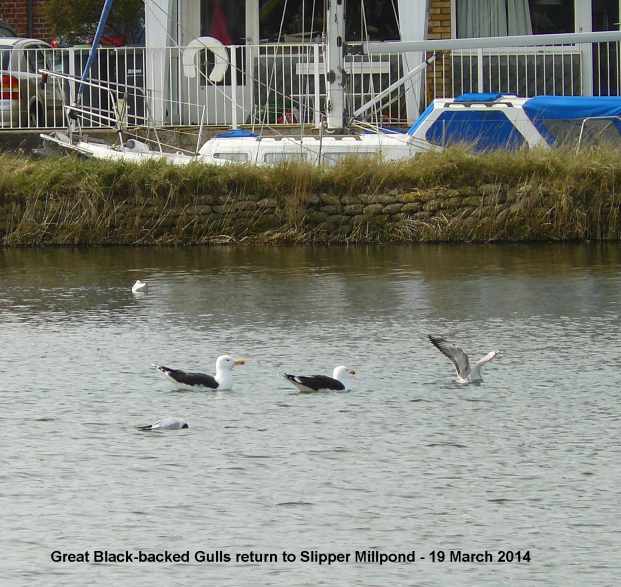
The pair of Mute Swans
was also on the pond with no sign any nesting.
Emsworth
Harbour
From the
millpond seawall I counted just 54 Brent Geese in the
eastern harbour and nothing else apart from the usual
gulls. This is clearly the end of the winter season.
Waysides
News
There is a
fine display of flowering Blackthorn on the
wayside path behind Lillywhite's Garage. Grape
Hyacinth is also out immediately behind the
conservation area notice.
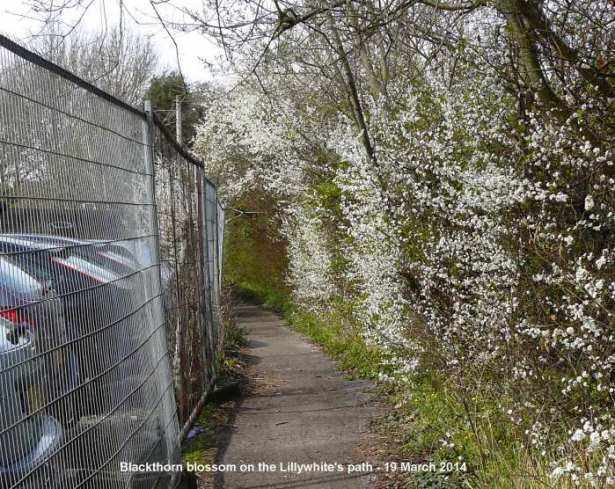
First
Orange Tip
In his blog
last night, Ralph Hollins reported news of what may be
the first Orange Tip butterfly to have emerged in
England this spring seen in Fareham on Mar 16 and
reported to John Goodspeed. See . . . http://ralph-hollins.net/Diary.htm
TUESDAY
MARCH 18 - 2014
NORE
BARN
15:00 -16:00 -
Tide falling from high water at 12:30.
Spotted
Redshank gone?
There was no
sign of the Spotted Redshank again this afternoon. Nor
was there anything on the pond at the head of Nore
Barn Creek where a Spotted Redshank was last year at
this time. The only birds in the stream today were
Greenshank and Little Egret. When I arrived there was
also a solitary Brent Goose.
All this points to the fact that the Spotted Redshank
has now left on its journey back to its breeding
grounds, probably in Northern Scandinavia. The last
confirmed sighting we had was on Mar 13 by Peter
Milinets-Raby, much earlier than last year (Mar 27),
though much in line with previous years. Generally,
this has been a good winter for sightings with two
'friendly' Spotted Redshanks being present on many
occasions along with the regular Greenshank and Little
Egret. Earlier in the season we also had a regular
juvenile Black-tailed Godwit in the stream.
For
full details of departure dates go
to . . .
Spotted
Redshank at Nore Barn
Bluebells
I walked
through the woods where I met Roy Ewing who was
surveying the area of Bluebells in a glade in the
western section of the woods. Roy told me that the
glade had been cleared two years ago by the Friends of
Nore Barn Woods and native bulbs planted which were
now growing well. There were far more than last year
and he was hoping some might flower this year. We
discussed the possibility of planting Early Purple
Orchids which would also enhance the flora of the
woods.
While we were talking
Roy and I were serenaded by the metronomic song of a
Chiffchaff, very likely an early migrant. I also heard
one singing in the woods yesterday. But there was no
sound of Blackcap as yet. Roy was hoping that
Sparrowhawks would be nesting in the woods as they
have done in previous years.
Nore
Barn to Warblington
Peter
Milinets-Raby was at Nore Barn this morning. He walked
along the shore to Pook Lane and back through the
church - 10:15am to 11:50am - tide pushing in. Very
little around - took ages to find anything - the wind
was a bit brisk!
Nore Barn: 31 Teal, 10
Wigeon, 2 Red breasted Mergansers, Later when I
returned at 11:45am (high tide) I managed to locate 23
Shelduck, a Great Crested Grebe and a Little Grebe. At
the top of the Nore Barn Creek was a single Greenshank
that moved onto the pond at high tide. 3 singing
Chiffchaff in woods. No Spotted Redshank!
Stubble fields behind
Conigar Point: 4 Skylark and one singing very high, 2
Med Gulls over, 38 Stock Doves, female Reed Bunting,
36 Linnets with 12 Goldfinch with them.
This pansy-like flower caught Peter's eye? Possible
Field Pansy (V. arvensis)? Ralph Hollins says
"Peter's find was definitiely Field Pansy which is
regularly found in my Field V. Not only is it there in
the autumn but this winter I found fresh flowering
plants of it on both Feb 4 and Mar 4".
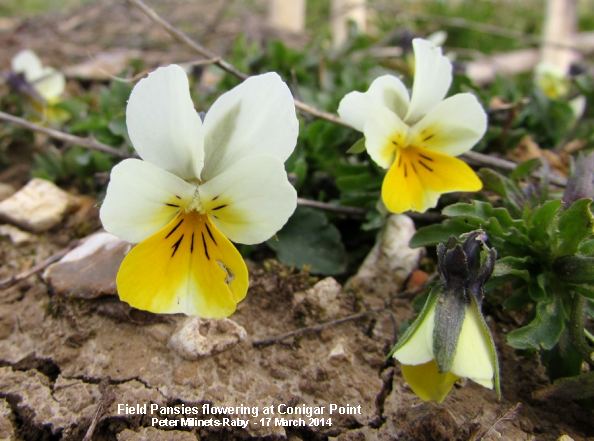
Off Conigar Point: 17
Brent Geese, 2 Wigeon, 5 Red Breasted Merganser, 4
Grey Plover, 3 Knot, 1 Turnstone.
Off Pook Lane: 25 Brent Geese, 2 Wigeon.
Regarding the possible
nesting Grey Heron at Langstone Mill Pond, Peter says
on almost every visit to the Mill Pond he has seen the
Grey Heron in the same tree. "The tree obscures the
bottom half of the heron, so I have no idea what it is
sitting on. But over the visits I have witnessed
display with a second bird, stick re-arranging and
aggression towards a Carrion Crow. I hope there is
something there! I'm sure they nested in the same spot
last year, but can not recall if I saw
youngsters."
Water
Voles
Pam Phillips
saw a Water Vole under the giant ash tree at
7.30am today. It was just above the shuttering again
eating ivy leaves.Water Vole sightings on Brook Meadow
are picking up after a slow start to the year. So far
we have had 12 sightings, mostly along the stretch of
river by the railway embankment and mostly by Pam and
Malcolm Phillips. Malcolm has got some great photos as
usual.
For all the current news see . . . http://www.brook-meadow.hampshire.org.uk/bm-water-voles-2014.html
MONDAY
MARCH 17 - 2014
Nore
Barn
09:30 - About
2 hours to high water. All very calm with very few
birds in view. I counted about 50 ducks, Wigeon and
Teal in Nore Barn Creek. The stream was empty, though
I did notice what was probably a Common Redshank (the
bill seemed a bit short for Spotted Redshank) swimming
in the water some way off shore.

We must be getting
fairly close to the Spotted Redshank leaving date. For
previous latest sightings go to . . . Spotted
Redshank at Nore Barn
Walking back through Nore Barn Woods I heard a
Chiffchaff singing, which is very likely a
migrant.
On the way to Nore Barn I noticed a good flowering of
Three-cornered Garlic beneath the Privet hedge
on the north side of Warblington Road just east of the
junction with Beach Road.

Brook
Meadow
Malcolm
Phillips was on Brook Meadow this morning. He had yet
another sighting of a Water Vole on the north
bank near the railway embankment.
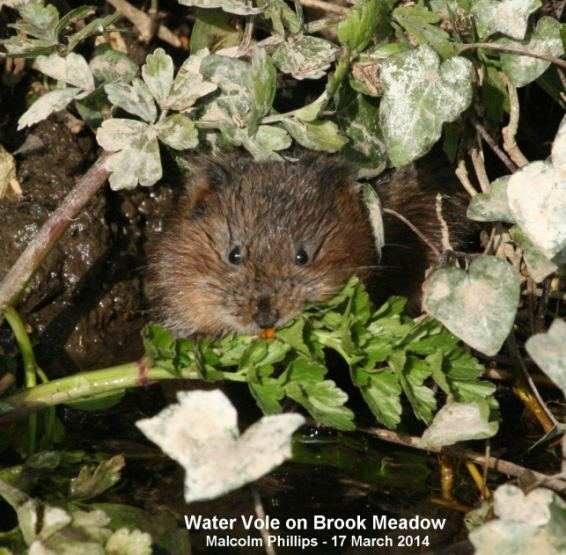
Malcolm also got a
good shot of two Small Tortoiseshells mating.
Another sign of their revival? However, Ralph Hollins
points out that the rear butterfly of the pair in
Malcolm's photo is facing the wrong way for successful
copulation.
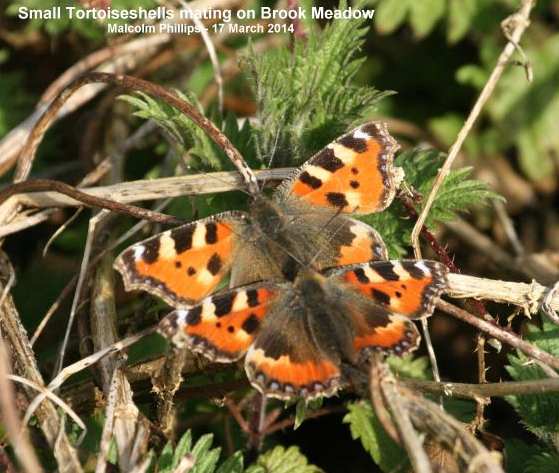
Langstone
Mill Pond
Peter
Milinets-Raby walked to Langstone Mill Pond via Wade
Lane this morning (10:10am to 11:50am). The highlights
were as follows:
Wade Lane: 4 Little Egrets feeding in the horse
paddock, 2 pairs of Mistle Thrushes. Singing
Chiffchaff, 1 Buzzard, Great Spotted Woodpecker.
Flooded paddock (fast drying out) north of the pond:
39 Teal, Grey Heron feeding, 18 Moorhen, 4 Med Gulls
over calling, Chiffchaff singing.
Off shore (almost high tide): 16 Red Breasted
Mergansers with a single Great Crested Grebe, 9 Teal,
37 Brent Geese, 7 Wigeon.
On the Langstone Mill Pond: Chiffchaff singing, Stock
Dove, 2 Buzzard soaring around.
Female Mute Swan looking truly settled on its nest.
Observed it pluck a few feathers from its breast after
a preening session and a rearrangement of some twigs.
As you can see from the photo this nest is very open
and close to the main footpath.

29 Little Egrets
present. Most roosting out the high water and still in
winter plumage. However, 12 were looking splendid in
their wonderful spring plumage and engaged in lots of
calling, chasing and ruffling of elaborate plumes. Of
these 12, four had flushed red feet. Two birds were
clearly establishing territories within the trees at
previous known nest sites. Much earlier than last
year, but there again it was still winter this time
last year!
Grey Heron observed on its usual tree rearranging
sticks, raising all its feathers in alarm to a Carrion
Crow that ventured too close and carrying out
Stork-like display of tossing head up and back. it
will only be a matter of time when chicks will be
seen.
Great
Crested Grebes
Chichester
Gravel Pits is certainly the best place locally to see
Great Crested Grebes displaying. Tony Wootton got this
superb image of a pair doing their special courtship
dance.
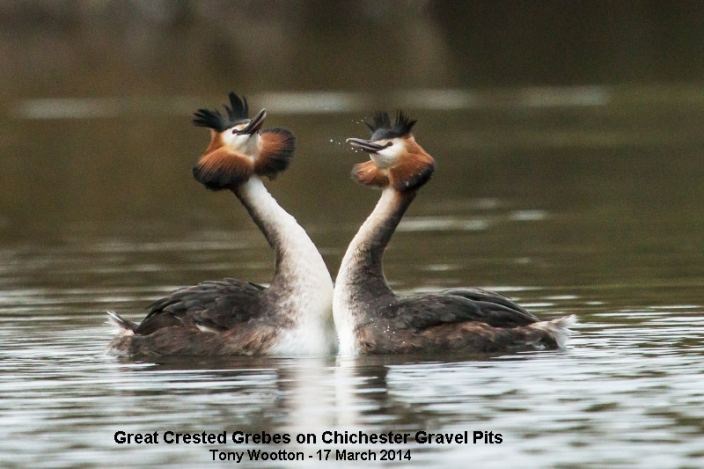
For
earlier observations go to . . March
1-16